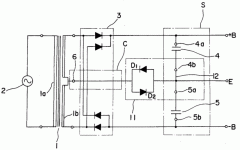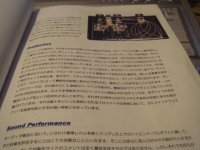john curl said:I can recommend two approaches. One is to add input filtering, both common mode and differential mode. The second is to add resistance and or significant inductance in series with the center tap of the secondary of the transformer, if it is used.
JC the same for dual bridge config (+/-)?
I remember an old article in Positive Feed back where you suggested an inductor from the secondary center tap to ground as an upgrade to the original JC-2 preamp. Do you still recommend this when using hi-isolation EI xfrmrs for preamps?
The capacitance between windings allows for a common mode connection between your amplification system and the power lines, if you connect the output of the rectifier system directly to chassis ground. That's not a good thing.
Adding an inductor to a center tap adds a series impedance that may help.
Reducing the coupling between primary and secondary does help, whether through transformer selection or "neutralization" of the capacitive coupling.
Using a balanced smoothing filter with only the output connected to amplifier "ground" (common, really) also helps.
All this can be modeled - it's plain engineering.
Not connecting the chassis ground to every other electrical product in the neighborhood also is a no-brainer.
If you examine the mechanisms that many amplifier circuits use to optimize PSRR and distortion, many are based around the idea of converting an undesired signal to a mode that the amplifier isn't responsive to. For example, common mode to differential mode. But, if you do anything to allow mode conversion to re-occur, you lose. Look at any text on amplifier feedback application for examples.
BTW - there's a lot of people who swear that power cables make no difference at all. After all, aside from the resistance, what is there? How about the differential to common mode coupling inherent within, especially to that ground wire? That doesn't even consider the susceptibility to radiated EMI.
Adding an inductor to a center tap adds a series impedance that may help.
Reducing the coupling between primary and secondary does help, whether through transformer selection or "neutralization" of the capacitive coupling.
Using a balanced smoothing filter with only the output connected to amplifier "ground" (common, really) also helps.
All this can be modeled - it's plain engineering.
Not connecting the chassis ground to every other electrical product in the neighborhood also is a no-brainer.
If you examine the mechanisms that many amplifier circuits use to optimize PSRR and distortion, many are based around the idea of converting an undesired signal to a mode that the amplifier isn't responsive to. For example, common mode to differential mode. But, if you do anything to allow mode conversion to re-occur, you lose. Look at any text on amplifier feedback application for examples.
BTW - there's a lot of people who swear that power cables make no difference at all. After all, aside from the resistance, what is there? How about the differential to common mode coupling inherent within, especially to that ground wire? That doesn't even consider the susceptibility to radiated EMI.
john curl said:When measuring capacitance, I don't think that you have to connect anything special. It is all relative, and Hi Z, rather than low Z where the transformer normally thinks it is operating.
Is it really the capacitance? I always thought it is more the tight, wideband coupling. Low leakage induction, that sort of thing.
They use toroids as 100kHz+ tube output xformers..
Jan Didden
john curl said:Now that Syn08's preamp is now outside the pathological range of operation, perhaps we should talk about other noise influences, rather than just the input stage. I had hoped to do this weeks ago, but got diverted.
In this, I mean power supply noise, both internally generated and externally induced from the power line, etc.
We have gone through heavy shielding before, but that has to be noted here, in any case.
Q.E.D.
- Modern opamps can be used today to build a better ultra low noise MC preamp than the 25 years old Vendetta SCP-2.
- Low noise JFETs are still required for ultra low noise MC.
- For MM, low noise JFETs are not required, modern opamps are good enough.
I'll send you a picture with the whole thing when it's fully done, for you to frame next to the SCP-2 🙂
Next target is the Blowtorch. It's more difficult, only because I've never seen a spec 😀
Don't worry, power supply technologies went better, in the last 25 years, as well 😀
john curl said:I can recommend two approaches. One is to add input filtering, both common mode and differential mode. The second is to add resistance and or significant inductance in series with the center tap of the secondary of the transformer, if it is used.
Input filtering can backfire badly, like the input modules Levinson used. Those coupled the line born noise back to the chassis ground and caused no end of hum problems interconnecting with other products. I would suggest looking for medical rated filters since they are low leakage types.
Finding transformers with low capacitance between primary and secondary is difficult. The Signal transformers with seperate primary and secondary bobbins are better, but the flux density is high in those. using a 220 Primary for 110 and a secondary with twice the target voltage helps at the expense of available power and regulation.
syn08 said:
Q.E.D.
- Modern opamps can be used today to build a better ultra low noise MC preamp than the 25 years old Vendetta SCP-2.
- Low noise JFETs are still required for ultra low noise MC.
- For MM, low noise JFETs are not required, modern opamps are good enough.
I'm really not interested in taking sides here. But, I'm not sure that it has been conclusively proven that modern opamps can be used build a "better" ultra low noise MC preamp.
You've definitely shown that the noise level is as good or even better, due to the JFETs, but the rest of the performance is still pretty much TBD. Is that an accurate statement?
Have you made in depth measurements of a completed unit yet?
Weren't you going to respin the board layout?
Have you actually listened to this phono section? Even if you might not believe in the worthiness of listening tests (I have no idea if you do or don't), at the very least listening might bring to light some aspect of performance that doesn't show up in even detailed instrument testing under real conditions.
syn08 said:only because I've never seen a spec
Mr Popa,
you think Master Milan's numbers will be so much of(f)-course ?

Attachments
john curl said:Syn08, has a 2 ohm advantage in noise. No more, and no less.
See? That's progress for you.
As has already been mentioned; the C coupling between prim and sec in a toriod is the issue. Look at medical grade units. These should have lower coupling.
When attempting to get this low a noise level. Earth is just as important as Line and Neutral.
Think about it.
When attempting to get this low a noise level. Earth is just as important as Line and Neutral.
Think about it.
If I change 4 input resistors from 10 ohms to 2 ohms, I will then have the SAME noise as Syn08 in my new VR3 phono stage. Thanks, Syno8, I might try it.
CG said:
I'm really not interested in taking sides here. But, I'm not sure that it has been conclusively proven that modern opamps can be used build a "better" ultra low noise MC preamp.
Yep, I've seen this coming

Let the debate begin! I'm out after beer and popcorn

Can't wait for another Bybee episode 🙂
john curl said:If I change 4 input resistors from 10 ohms to 2 ohms, I will then have the SAME noise as Syn08 in my new VR3 phono stage. Thanks, Syno8, I might try it.
Do I hear "royalties"?
Edit: this thing really needs a servo. It's ready, tested and I'll post it after I complete and test the whole preamp (over the weekend).
jacco vermeulen said:
Mr Popa,
you think Master Milan's numbers will be so much of(f)-course ?
http://web.telecom.cz/macura/pre.pdf
The CTC Blowtorch line amp runs open loop. This means that it is difficult to reduce the distortion to 'unmeasurable' levels. However, it sounds better than any preamp that I have ever made that uses global feedback, including the new Parasound JC-2 preamp. I am with Chas Hansen on this. Open loop just sounds better. I already know how to make very low distortion products, now my quest is for better sounding products.
syn08 said:
Yep, I've seen this coming
Let the debate begin! I'm out after beer and popcorn
Can't wait for another Bybee episode 🙂
Seen WHAT coming?
I recognized that you've built a preamp that has noise performance as good or better than an older design.
Based on what you've said so far, unless I missed it, you haven't finished this design as you are laying out a new circuit board. Is that correct?
I then asked what your results are. Not the simulation, but the actual results. There was no demand or strong request for any kind of carefully executed listening comparison or anything of the sort. I simply asked, in what I thought was a civil and polite way, for you to provide the same level of proof that you have suggested is needed from others. How can you claim any kind of results when there aren't any yet?
Now who's the one changing the subject when pressed?
(For the record, at present I myself am using an opamp based phono section. Well, not really at present since I am in a different room typing this. Hopefully that still counts the same.)
john curl said:The CTC Blowtorch line amp runs open loop. This means that it is difficult to reduce the distortion to 'unmeasurable' levels. However, it sounds better than any preamp that I have ever made that uses global feedback, including the new Parasound JC-2 preamp. I am with Chas Hansen on this. Open loop just sounds better. I already know how to make very low distortion products, now my quest is for better sounding products.
Hi John
How would you define “better sounding products”?
Stinius
- Status
- Not open for further replies.
- Home
- Amplifiers
- Solid State
- John Curl's Blowtorch preamplifier

